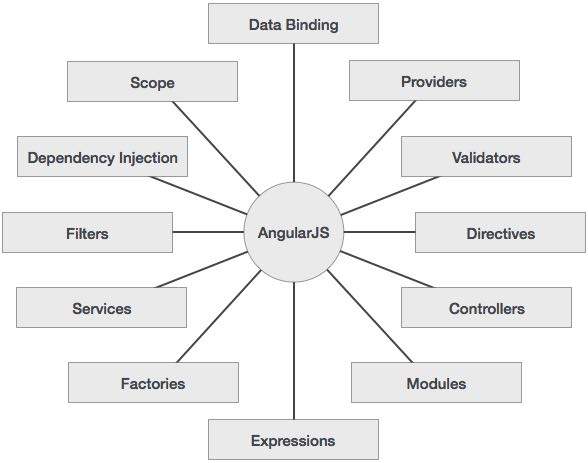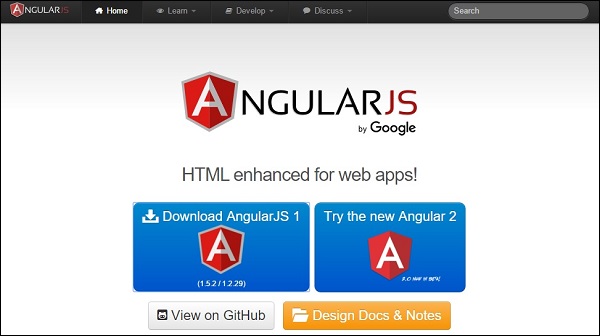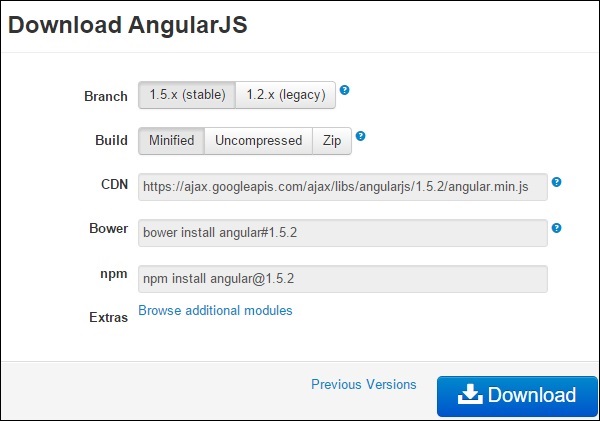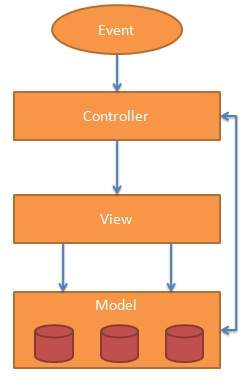What is AngularJS?
AngularJS is an open source web application framework. It was originally developed in 2009 by Misko Hevery and Adam Abrons. It is now maintained by Google. Its latest version is 1.4.3.Definition of AngularJS as put by its official documentation is as follows −
AngularJS is a structural framework for dynamic web apps. It lets you use HTML as your template language and lets you extend HTML's syntax to express your application's components clearly and succinctly. Angular's data binding and dependency injection eliminate much of the code you currently have to write. And it all happens within the browser, making it an ideal partner with any server technology.
Features
- AngularJS is a powerful JavaScript based development framework to create RICH Internet Application(RIA).
- AngularJS provides developers options to write client side application (using JavaScript) in a clean MVC(Model View Controller) way.
- Application written in AngularJS is cross-browser compliant. AngularJS automatically handles JavaScript code suitable for each browser.
- AngularJS is open source, completely free, and used by thousands of developers around the world. It is licensed under the Apache License version 2.0.
Core Features
Following are most important core features of AngularJS −- Data-binding − It is the automatic synchronization of data between model and view components.
- Scope − These are objects that refer to the model. They act as a glue between controller and view.
- Controller − These are JavaScript functions that are bound to a particular scope.
- Services − AngularJS come with several built-in services for example $https: to make a XMLHttpRequests. These are singleton objects which are instantiated only once in app.
- Filters − These select a subset of items from an array and returns a new array.
- Directives − Directives are markers on DOM elements (such as elements, attributes, css, and more). These can be used to create custom HTML tags that serve as new, custom widgets. AngularJS has built-in directives (ngBind, ngModel...)
- Templates − These are the rendered view with information from the controller and model. These can be a single file (like index.html) or multiple views in one page using "partials".
- Routing − It is concept of switching views.
- Model View Whatever − MVC is a design pattern for dividing an application into different parts (called Model, View and Controller), each with distinct responsibilities. AngularJS does not implement MVC in the traditional sense, but rather something closer to MVVM (Model-View-ViewModel). The Angular JS team refers it humorously as Model View Whatever.
- Deep Linking − Deep linking allows you to encode the state of application in the URL so that it can be bookmarked. The application can then be restored from the URL to the same state.
- Dependency Injection − AngularJS has a built-in dependency injection subsystem that helps the developer by making the application easier to develop, understand, and test.
Concepts
Following diagram depicts some important parts of AngularJS which we will discuss in detail in the subsequent chapters.
Advantages of AngularJS
- AngularJS provides capability to create Single Page Application in a very clean and maintainable way.
- AngularJS provides data binding capability to HTML thus giving user a rich and responsive experience
- AngularJS code is unit testable.
- AngularJS uses dependency injection and make use of separation of concerns.
- AngularJS provides reusable components.
- With AngularJS, developer write less code and get more functionality.
- In AngularJS, views are pure html pages, and controllers written in JavaScript do the business processing.
Disadvantages of AngularJS
Though AngularJS comes with lots of plus points but same time we should consider the following points −- Not Secure − Being JavaScript only framework, application written in AngularJS are not safe. Server side authentication and authorization is must to keep an application secure.
- Not degradable − If your application user disables JavaScript then user will just see the basic page and nothing more.
The AngularJS Components
The AngularJS framework can be divided into following three major parts −- ng-app − This directive defines and links an AngularJS application to HTML.
- ng-model − This directive binds the values of AngularJS application data to HTML input controls.
- ng-bind − This directive binds the AngularJS Application data to HTML tags.
AngularJS - Environment Setup
In this chapter we will discuss about how to set up AngularJS library to be used in web application development. We will also briefly study the directory structure and its contents.Try it Option Online
You really do not need to set up your own environment to start learning AngularJS. Reason is very simple, we already have set up AngularJS environment online, so that you can execute all the available examples online at the same time when you are doing your theory work. This gives you confidence in what you are reading and to check the result with different options. Feel free to modify any example and execute it online.
Try the following example using Try it option available at the top right corner of the below sample code box −
<!doctype html> <html ng-app> <head> <script src = "https://ajax.googleapis.com/ajax/libs/angularjs/1.3.3/angular.min.js"></script> </head> <body> <div> <label>Name:</label> <input type = "text" ng-model = "yourName" placeholder = "Enter a name here"> <hr /> <h1>Hello {{yourName}}!</h1> </div> </body> </html>For most of the examples given in this tutorial, you will find Try it option, so just make use of it and enjoy your learning.
When you open the link https://angularjs.org/, you will see there are two options to download AngularJS library −

- View on GitHub − Click on this button to go to GitHub and get all of the latest scripts.
- Download − Or click on this button, a screen as below would be seen −

- This screen gives various options of using Angular JS as follows −
- Downloading and hosting files locally
- There are two different options legacy and latest. The names itself are self descriptive. legacy has version less than 1.2.x and latest has 1.4.x version.
- We can also go with the minified, uncompressed or zipped version.
- CDN access − You also have access to a CDN. The CDN will give you access around the world to regional data centers that in this case, Google host. This means using CDN moves the responsibility of hosting files from your own servers to a series of external ones. This also offers an advantage that if the visitor to your webpage has already downloaded a copy of AngularJS from the same CDN, it won't have to be re-downloaded.
- Downloading and hosting files locally
We are using the CDN versions of the library throughout this tutorial.
Example
Now let us write a simple example using AngularJS library. Let us create an HTML file myfirstexample.html as below −<!doctype html> <html> <head> <script src = "https://ajax.googleapis.com/ajax/libs/angularjs/1.3.0-beta.17/angular.min.js"></script> </head> <body ng-app = "myapp"> <div ng-controller = "HelloController" > <h2>Welcome {{helloTo.title}} to the world of Tutorialspoint!</h2> </div> <script> angular.module("myapp", []) .controller("HelloController", function($scope) { $scope.helloTo = {}; $scope.helloTo.title = "AngularJS"; }); </script> </body> </html>Following sections describe the above code in detail −
Include AngularJS
We have included the AngularJS JavaScript file in the HTML page so we can use AngularJS −<head> <script src = "https://ajax.googleapis.com/ajax/libs/angularjs/1.3.14/angular.min.js"></script> </head>Check the latest version of AngularJS on their official website.
Point to AngularJS app
Next we tell what part of the HTML contains the AngularJS app. This done by adding the ng-app attribute to the root HTML element of the AngularJS app. You can either add it to html element or body element as shown below −<body ng-app = "myapp"> </body>
View
The view is this part −<div ng-controller = "HelloController" > <h2>Welcome {{helloTo.title}} to the world of Tutorialspoint!</h2> </div>ng-controller tells AngularJS what controller to use with this view. helloTo.title tells AngularJS to write the "model" value named helloTo.title to the HTML at this location.
Controller
The controller part is −<script> angular.module("myapp", []) .controller("HelloController", function($scope) { $scope.helloTo = {}; $scope.helloTo.title = "AngularJS"; }); </script>This code registers a controller function named HelloController in the angular module named myapp. We will study more about modules and controllers in their respective chapters. The controller function is registered in angular via the angular.module(...).controller(...) function call.
The $scope parameter passed to the controller function is the model. The controller function adds a helloTo JavaScript object, and in that object it adds a title field.
Execution
Save the above code as myfirstexample.html and open it in any browser. You will see an output as below −Welcome AngularJS to the world of Tutorialspoint!When the page is loaded in the browser, following things happen −
- HTML document is loaded into the browser, and evaluated by the browser. AngularJS JavaScript file is loaded, the angular global object is created. Next, JavaScript which registers controller functions is executed.
- Next AngularJS scans through the HTML to look for AngularJS apps and views. Once view is located, it connects that view to the corresponding controller function.
- Next, AngularJS executes the controller functions. It then renders the views with data from the model populated by the controller. The page is now ready.
AngularJS - MVC Architecture
Model View Controller or MVC as it is popularly called, is a software design pattern for developing web applications. A Model View Controller pattern is made up of the following three parts −- Model − It is the lowest level of the pattern responsible for maintaining data.
- View − It is responsible for displaying all or a portion of the data to the user.
- Controller − It is a software Code that controls the interactions between the Model and View.

The Model
The model is responsible for managing application data. It responds to the request from view and to the instructions from controller to update itself.The View
A presentation of data in a particular format, triggered by the controller's decision to present the data. They are script-based template systems such as JSP, ASP, PHP and very easy to integrate with AJAX technology.The Controller
The controller responds to user input and performs interactions on the data model objects. The controller receives input, validates it, and then performs business operations that modify the state of the data model.AngularJS is a MVC based framework. In the coming chapters, we will see how AngularJS uses MVC methodology.

No comments:
Post a Comment